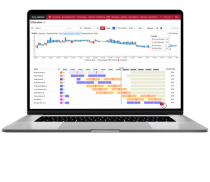- Products
- Solutions
Solutions
Services
- Resources
- Customers
Explore CSCCalabrio Success Center
Calabrio product training
- Partners
Guide to Call Center Workforce Management: Best Practices & ToolsFind More Great Content- Customer Interaction Analytics
- Workforce Management
- Customer Experience
- Quality Management
- Contact Center Reporting
- Managing a Remote Workforce
Home » Workforce Optimization » 5 Strategies to Improve Agent Experience in the Call Center
5 Strategies to Improve Agent Experience in the Call Center
Hot off the heels of our successful C3 events in Nashville and London, and all the great workforce engagement management (WEM) presentations I saw there, I’m reminded once again how tightly tied highly engaged employees are to superior customer experiences. You just can’t have one without the other.
Leading contact centers know this, and—time and again—we see them use five proven strategies to boost agent engagement, improve retention and enhance skill development to engineer better customer experiences from the inside out:
- Give agents greater control over work arrangements
- Invest in seamless agent workflows
- Empower agents with self-improvement tools
- Get smart about leadership
- Demonstrate the business value of the contact center
We dive deeper into these strategies in our new ebook 5 Enhancing Agent Engagement: 5 WEM Strategies to Drive Better Customer Experience from the Inside Out, but the topic is such a hot one, it warrants additional insight. That’s why I recently tapped Calabrio Contact Center Analytics Consultant Robin Butterfield and Workforce Management (WFM) Consultant Laura Lukic for their expert insight on these strategies and what they see in the field. Here’s what they had to say.
Thank you so much for taking the time to share your real-world perspective on these powerful strategies. The first WEM strategy is a very popular one with our customers—how do you see contact centers adjusting their policies to give agents greater control over their work arrangements?
[Robin] Flexible scheduling and shift bidding are the two most common tactics I see used. Also rising in popularity is letting agents self-serve online to see available paid time off (PTO), so they proactively can plan the best time to take a vacation.
[Laura] I agree—flexible scheduling and shift bidding are very popular. I also see shift trading to be a benefit agents value. Typically, companies with good cultures get really creative with what they offer. And, even though there are many things that can make agents feel they’re important when you talk about the culture or the business, not all ideas are do-able. For instance, everyone loves the idea of working from home, but some businesses can’t offer it because of compliance reasons. Luckily, there are other things you can do to create that kind of flexible environment that inspires agents to take ownership of the way they work. And ultimately, that’s what makes a great culture—having that kind of flexibility mentality built into your environment.
Absolutely. And how do you see contact centers investing in seamless agent workflows?
[Robin] Omnichannel is a big tactic companies are using right now. Contact centers leveraging large WFM systems can use omnichannel to schedule different types of activities to interleaf across different communication channels throughout the day. The one caveat is that not all agents are effective across all channels—some people are great on the phone but not so great when communicating on chat or via email. So companies that implement agent workflows across multiple channels need to be dedicated to managing, training and coaching agents for an omnichannel world. Often times that means different types of coaching for different types of channels.
[Laura] It may seem self-evident to say so, but, when it comes to optimizing workflows, processes are really important. There aren’t always many processes in place in contact centers, so I spend a lot of time explaining to customers which processes can help them run their business in the most optimized manner. Creating processes is important because what makes agents crazy is dysfunction in the contact center. For example, they have too many apps they’re supposed to use every day, and those apps don’t all talk to each other. It’s not an easy world out there for agents. And it’s easy to blame the software or apps for this kind of dysfunction, but problems often are caused by a lack of process. Contact centers need sensible, documented processes in place that everyone understands and to which agents are expected to adhere and be held accountable.
Empowering agents with self-improvement tools is the third WEM strategy we discuss in our new ebook. What are your thoughts regarding this approach?
[Robin] I’m a big proponent of allowing agents to not only log in to Calabrio to see schedules and time-off requests, but also allowing them to self-serve in a variety of other ways using tools that give them access and empowerment. Let them playback and listen to their own call recordings to proactively gather insights and reflect upon how they could have handled interactions in a more positive or effective way. Let agents flag interactions on which they would like more coaching from their supervisors. Let them open files and recordings on their own, kind of like a library, so they can self-serve to look for calls for ongoing training and improvement. Let agents self-serve on their evaluations, rather than waiting for bi-monthly coaching sessions, so they can reflect upon the evaluation themselves—often they’re less defensive using this approach than when they receive that feedback from supervisors.
[Laura] What I like about modern WEM self-improvement tools are the full transparency into the business that they provide—what are the contact center’s goals, how do those tie into the company’s core goals, what are we going to do to achieve them and how productive is the contact center on a day-to-day basis? It’s not enough anymore to simply show quarterly or annual results—sharing and monitoring progress against metrics have to be ongoing processes. That means arming agents with tools that allow them to become better at what they do. Companies can’t deliver great customer experiences if agents don’t understand in real time on what they need to improve and how their efforts tie back to the company’s bottom line. Agents have the most important role when it comes to the customer experience, so it’s critical that they feel like they’re an integral part of the business.
Getting smart about contact center leadership is another top strategy we see used to implement WEM, but some companies struggle to understand what this really means. What do you see?
[Robin] There are a ton of ways to go about this. One method I see used is leadership inviting agents to calibrate new agent evaluation forms. By having agents QA new forms and then evaluate their peers, they buy into the process more so than before because they’ve already completed the process in a training capacity. Additionally, we have new, streamlined functionality in Calabrio that openly encourages agents to appeal the evaluation process—they can either acknowledge the evaluation or acknowledge and appeal the evaluation.
[Laura] Know your contact center leaders’ strengths and weaknesses because you want to make sure you have the right leaders in the right roles. For instance, some leaders are great with people while others are great with technology. This change alone will make a huge difference because it’s so important in the contact center world. Contact center life is such a different, unique type of environment—you absolutely must make sure you have the right people in the right position.
Lastly, contact centers leading the charge with WEM make it a priority to consistently demonstrate the business value their contact center delivers. What are metrics they use or ways you see them do this?
[Robin] The most powerful metrics a contact center can use tend to be tied to the business’s overall objectives. The more direct the correlation between contact center results and positive business results, the higher the perceived value of the contact center. That said, there are countless ways to demonstrate the business value of a contact center. Some companies track the percent of time agents spend in “good” applications—this typically is measured as productive versus non-productive time. I know a mobile phone retailer that used speech analytics and a list of common phrases indicative of customer complaints to find out why they were experiencing an increase in customer complaints. They discovered agents were giving wrong instructions on how to rectify a known problem with a SIM card, so they quickly updated their agent training documentation to resolve the issue and return to business as usual. And an appliance retailer experiencing an increase in customer inquiries discovered one of its refrigerator models had an issue with its handle. They quickly rectified that problem by proactively notifying customers of the issue and their intended resolution for it before sending out a new handle from the manufacturer. By taking proactive action, they reduced future call volume and increased customer satisfaction.
[Laura] Contact centers are usually a company’s biggest cost, so it’s imperative they prove their value time and again. And it all kind of starts at the executive level. That executive level determines what is the business value of the contact center, what is its end goal and who are the key players. More and more today, the executive level is more involved in the contact center because they want to make sure the contact center—and the personality of the contact center—is aligned with the goals of the business.
Find out how you can boost agent engagement, improve retention and enhance skill development to engineer better a better agent and customer experience by downloading our new ebook, Enhancing Agent Engagement: 5 WEM Strategies to Drive Better Customer Experience from the Inside Out.
Recent PostsCalabrio is a trusted ally to leading brands. The digital foundation of a customer-centric contact center, the Calabrio ONE workforce performance suite helps enrich and understand human interactions, empowering your contact center as a brand guardian.
We maximize agent performance, exceed customer expectations, and boost workforce efficiency using connected data, AI-fueled analytics, automated workforce management and personalized coaching.
Only Calabrio ONE unites workforce optimization (WFO), agent engagement and business intelligence solutions into a true-cloud, fully integrated suite that adapts to your business.
For customers and partners.
© Copyright 2024 Calabrio, Inc.How to engage and develop the digital workforce: 8 best practicesA Guide to Call Center Sentiment Analysis & MeasurementSend this to a friend - Solutions












